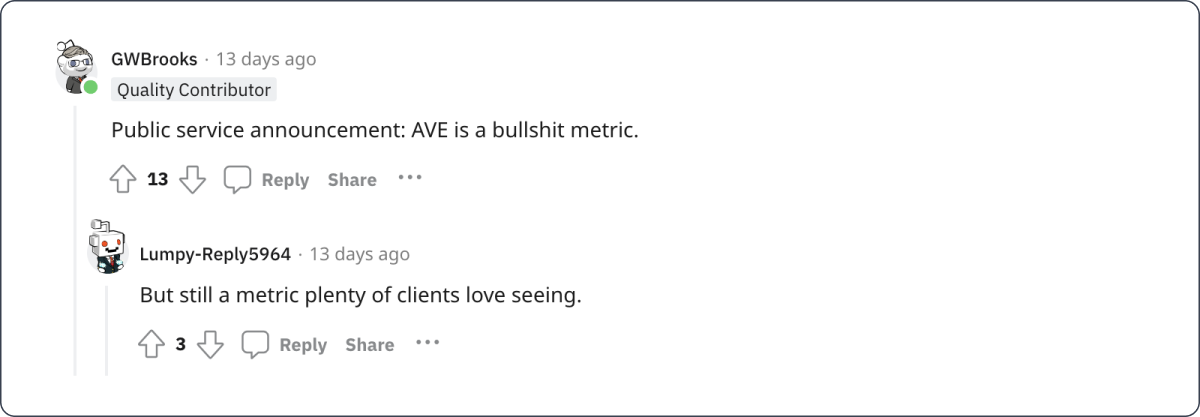The magical formula for calculating PR value ✨
JK! There's no secret sauce, so don't waste your time looking for one. Instead, do these three things (you won't believe #2!)
What? There isn't a single formula for calculating the value of your PR work? Well shucks, Batman, I could never have guessed. It's almost like anyone writing an article about the One True PR Value Formula Calculation is a digital marketer peddling SEO-nake oil.
Ready to take the guesswork out of your PR strategy?

If you've arrived at this article, my guess is that you're doing the obligatory cursory Google to find out whether there are any shortcuts you can take to measure what you've done, or are planning to do. More likely than not, there's a marketing manager sitting at the other end of the room (or Zoom), tapping their pen against the table and narrowing their eyes at the back of your head because where are the hard figures that justify you being here?
After all, the company made an investment when they hired you, when they forked out for that Cision subscription that you've definitely accessed more than one time in the past four months. Where are the flocks of TikTok followers you promised them? Where are the NYT headlines celebrating their groundbreaking strategic framework for engaging PR stakeholders?
Where are the millions of dollars in revenue, Kate??
Here's the closest you will get to your magical formula or secret snake sauce or whatever. No, it isn't a magic potion. Yes, it does work.
- Write down your (or your client's) overall business goals
- Work with them to outline a PR goal that aligns with #1
- Sit in a dark room and mindmap until you decide on:
- the tactics you will use to reach your PR goal
- the metrics you will use to measure progress
Now you're ready to go full steam ahead on executing your PR tactics, regularly checking up on your chosen metrics to make sure you're making progress, and adjusting course (or returning to the drawing board entirely) when you see that things clearly aren't working.
That's it!
So "hard work" was the answer all along. Sorry :( I know, I feel like television misled me too.
On the bright side, there's some info below to help you get to grips with the steps above :)
Ready to take the guesswork out of your PR strategy?

Your PR strategy is the what, how, and why that underpins your whole PR campaign.
Can you get by without one? Yup – thousands do. But those are the same thousands that churn clients and don't progress to that top wrung in their career ladder.
They're also the people working late into a Friday night, hair a bird's nest as they shake their laptop and sob "why isn't this working?!" into the screen before reaching for that third mega pint of wine.
We've all been there, and that's fine, but it isn't a place you want to stay for very long.
By taking some time to plan out a strategy before you start doing it, you're able to immediately exclude a whole bunch of unnecessary activities, and narrow down a manageable list of tactics that will let you achieve more in less time. Because why?
✨ More is not always better! ✨
(It's alright, we'll get there.)
This isn't some bogus claim that never actually pays off, it isn't a trick. It just takes some forethought, communication, and a bit of discipline.
And that's hard. Of course, it's hard because as humans we have a horrible time motivating ourselves to do more now so that we might reap the rewards later. And if that sounds a little too on the nose, I super recommend listening to the audiobook Hyperfocus by Chris Bailey. No affiliation, it's just helped me a lot :)
I also recommend reading about how you can build a PR strategy, featuring industry heroes Gini Dietrich of Spin Sucks and Laura Sutherland of PR Fest.
This is another area that has no clear-cut answer because what PR metrics you measure depends entirely on the goal of your PR campaign and the tactics you choose.
If you were trying to increase the amount you can benchpress, you probably wouldn't be tracking your progress with a pedometer, you know what I'm saying? You absolutely could track that number, because why not, you already bought the pedometer and your favourite Starbucks is a solid 1,200 steps from your front door… but it would be a pretty crappy indicator of your bench pressing progress. (This is where things like vanity metrics get into it.)
TL;DR: The thing you measure needs to make sense in the context of what you're doing and what you want to achieve.
With every PR software in the world coming up with its own analytics slap-on, it would be easy to just report on all of the things, but it's a waste of time. Why? Because ✨ more is not always better! ✨ That's right.
So, I can't tell you which metrics to definitely use. But, I can give you some options.
- Media coverage – an old favorite but sometimes problematic metric, media coverage is nevertheless a strong contender if your goal is to increase brand authority demonstrate thought leadership within a particular sector, or get in front of a specific audience – just so long as you remember that bigger isn't always better
- Campaign engagement – so, things like email open rate, clickthrough rate, replies, bounces and unsubscribes – analytics you can see if you send your campaigns through a tool like, say, Prezly's PR outreach software (which comes with a free trial) 🌝
- Web traffic – this is the measure of how many people are accessing your online content at any given time. You can measure web traffic with tools like Plausible Analytics and Ahrefs, or you can use your site publisher's built-in analytics dashboard
- Conversions – the number of people that become followers, clients or customers after participating in your campaign. This can be a valuable metric since it's often straightforward to track and tends to have a direct impact on business goals such as increasing sales
One thing that many PRs overlook is their site or newsroom traffic, normally because they're working with a boss or client who still thinks that PR = media relations, despite the fact that it's 2025 and the internet has been around for a hot minute. I urge you to be open-minded. Yes, digital has been the preserve of marketing, but there's absolutely no reason why public relations can't benefit. Use your newsroom data to show that your work has value (and that it converts), as well as to learn what content your audience best responds to so you can be even more effective in the future.
To go more in-depth into the different metrics available, check out our article on PR metrics and KPIs, or watch my premiere attempt at live streaming as I interview the king of data, Christopher S. Penn, about PR's big tech problem.

Hey, we're not here for grammar.
And it's an obligatory note, because it's something that was sort of relevant several decades ago, and has somehow persevered into present-day PR measurement by surfing atop an enduring wave of misconception about what PR actually is. (If you're interested, you can take a walk through the history of media monetization.)
Why? Because it's easy. It takes virtually no effort to find out how much it would have cost you to have placed that same earned content as an ad, and the result is a solid monetary figure that can't really be argued against.

"This would have cost us $10k to buy, and look, we got it for free! That's $10k of value for us right there."
Sure, that logic checks out.
And similarly, when your friend Dave was tragically forced to wrap up his fish & chip business and you managed to land his surplus inventory at no cost whatsoever, technically you won another $2k of value for your business, even if that value was locked away in a rapidly diminishing fishy commodity that frankly is already starting to smell a bit ripe.
But did it bring you and your company any closer to achieving any of your goals? Unless the main KPI was "seagull retention", I'd wager not so much. The value of having $2k-worth of fish is worth around $2k to a fishmonger, and approximately zero to, say, a SaaS platform.
You might ask, but Kate, what's that got to do with the price of fish?
Well, the simple truth of the matter is that the value of an ad isn't in the having of it; it's in the awareness it causes, the action that it inspires. And that's a very different thing to its price tag.
For one thing, it can change from issue to issue. For another, having the equivalent space as earned media is likely to be far more effective than a paid placement, since an editor would have vetted our story and deemed it relevant to their readership. That's why earned media carries such kudos, and why people try to piggyback on that kudos by doing things like using advertorials for their PR.
Well, here's one helpful suggestion from Quora (bearing in mind that this was 12 years ago, and even then AVE was dead):

The way most people who want to report on AVE due to, I assume, severe pressure from a client do so by checking what it would cost to run an ad of the same size in the same publication, and reporting on that. (Hence "ad value".) Sometimes they'll throw in a 2x or 3x multiplier, or at least that's what I've been told. I'm fuzzy as to why.
There's also a slightly better way.
If you must use a semblance of advertising value equivalency for measuring the success of your PR, speak with the publication and find out its reach. Find out how many people they claim are likely to see such an ad, and who those people are. Get their distribution figures. All this information is likely to be given prominently in their paid promo materials, and each one is infinitely more useful to figuring out the value of your PR mention than AVE.
Ready to take the guesswork out of your PR strategy?

Communication.
Alright, I'm not just being glib here. I mean communication between you and the company – whether that's in-house or a client – about aligning your goals and theirs.
Before you can get any effective tactics planned or even start to make a plan for your campaign, you need to make sure that you and the cats at the top are on the same page. Because a lot of the time, their idea of great PR is nowhere near reality.
And that isn't always easy, as Gini knows all too well. Fortunately, she has a trick for dealing with it. And by "trick", I mean a whole lot of patience. Take a look.
And it doesn't end there! Of course, it doesn't, because since when was PR easy?
Even if you get to the point where you and the CEO are aligned on the company's goals and how your work ties in with those, there's a good chance you still won't have the whole picture.
Take the time to speak with the different teams in the company, particularly marketing (yes, I know we hate them, but it's 2025 and the lines between us all are getting pretty blurry, so let's suck it up and try to be friendly here).
Find out what attribution models they use, and make sure to clue them in on the work you plan to do so that your PR work can be part of that picture. Because guess what – if you run a campaign that lures more visitors to the site but they can't track that the source of that traffic was your email? You won't see any of that credit. This is precisely why a PR campaign tool with built-in analytics can be so darn useful for reporting.
Ok, that's all folks! I hope this article didn't frighten you off, because although it is a lot of work to build out a PR strategy and track the right metrics, I promise you it's the only way to calculate the value of your PR – and best of all, by planning your work and selecting tactics that are actually going to "move the needle", you save yourself time and get better results in the long run. It's a way to invest in yourself.
If you still haven't had enough, I thoroughly recommend watching our interview with Richard Bagnall about what PR metrics to report on – the man who literally wrote the book on PR measurement.
Until next time, wishing you a productive day :)
Ready to take the guesswork out of your PR strategy?

Ready to start growing your media reach?
With Prezly you can publish press releases online, and share them directly with journalists. 14-day free trial, no credit card required.



